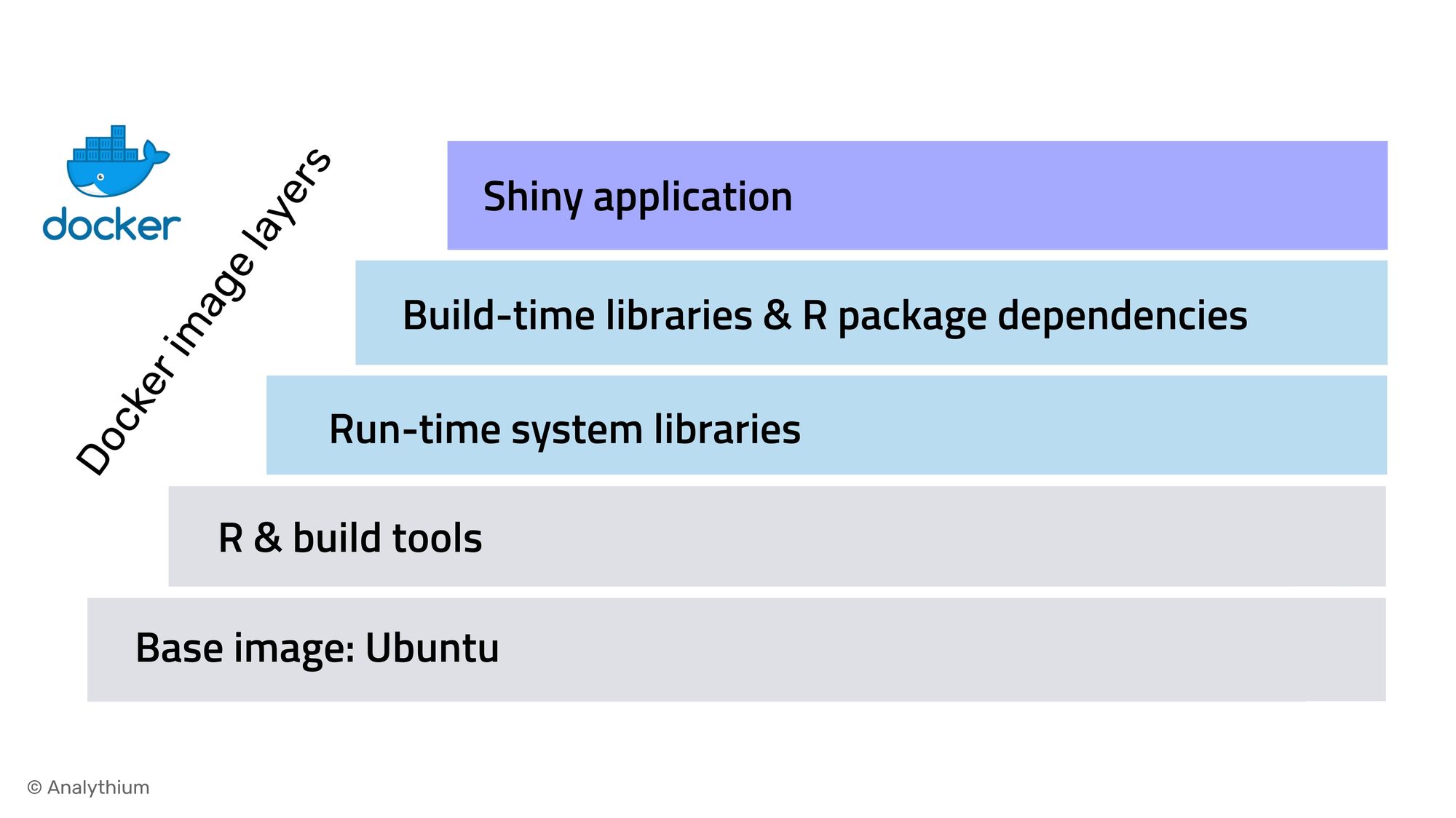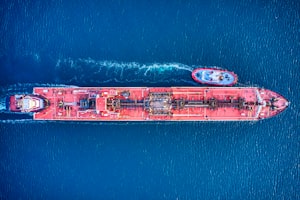How following a few basic suggestions for writing Dockerfiles can hugely improve the developer experience and the quality of the final Docker images.
The use of Docker with R has been transformative in many ways over the past 5 years. What is common in this diversity of use cases is that the Docker images almost always start with a parent image. What parent image you use? How do you add new layers to it? These questions will determine how quickly you can iterate while in development, and the size of the final image you send to production. In this post, I will compare using different parent images and outline best practices. I focus on Shiny apps but most of these ideas apply generally to any dockerized R application, like images for compute jobs or interfaces.
Parent images
In the previous post, we explored dependency management for Shiny apps using the rocker/r-ubuntu:20.04 as the parent image. A parent image is an image that you define in the FROM directive of the Dockerfile. A base image has FROM scratch as the first line. The R base images start with parent images. For example, the R Ubuntu image starts with FROM ubuntu:focal.
Here are the four commonly used parent images for R:
docker pull rhub/r-minimal:4.0.5
docker pull rocker/r-base:4.0.4
docker pull rocker/r-ubuntu:20.04
docker pull rstudio/r-base:4.0.4-focal
The image sizes vary quite a bit with the Alpine Linux base rhub/r-minimal being smallest and the Ubuntu-based rstudio/r-base 25x the size of the smallest image:
$ docker images --format 'table {{.Repository}}\t{{.Tag}}\t{{.Size}}'
REPOSITORY TAG SIZE
rhub/r-minimal 4.0.5 35.3MB
rocker/r-base 4.0.4 761MB
rocker/r-ubuntu 20.04 673MB
rstudio/r-base 4.0.4-focal 894MBThe Debian Linux based rocker/r-base Docker image from the Rocker project is considered bleeding edge when it comes to system dependencies, i.e. latest development versions are usually available sooner than on other Linux distributions.
The two Ubuntu Linux based images, rocker/r-ubuntu and rstudio/r-base from the Rocker project and from RStudio are for long-term support Ubuntu versions and use the RSPM CRAN binaries.
The Alpine Linux based rhub/r-minimal Docker image from the r-hub project is preferred for its small image sizes.
Using BildKit
Docker versions 18.09 or higher come with a new opt-in builder backend called BuildKit. BuildKit prints out a nice summary of each layer including timing for the layers and the overall build. This is the general build command that I used to compare the four parent images:
DOCKER_BUILDKIT=1 docker build --no-cache -f $FILE -t $IMAGE .
BuildKit backend is enabled by turning on the DOCKER_BUILDKIT=1 environment variable. I use the --no-cache option to avoid using cached layers, thus having a fair assessment of build times (you usually only build 1 and not 4). The -f $FILE flag allows building from different files kept in the same folder.
All the code used here can be found in this GitHub repository, look in the folder 99-images:
Image build times
This is the script I used to build the four images with BuildKit:
# rhub/r-minimal
export IMAGE="analythium/covidapp-shiny:minimal"
export FILE="Dockerfile.minimal"
DOCKER_BUILDKIT=1 docker build --no-cache -f $FILE -t $IMAGE .
# rocker/r-base
export IMAGE="analythium/covidapp-shiny:base"
export FILE="Dockerfile.base"
DOCKER_BUILDKIT=1 docker build --no-cache -f $FILE -t $IMAGE .
# rocker/r-ubuntu
export IMAGE="analythium/covidapp-shiny:ubuntu"
export FILE="Dockerfile.ubuntu"
DOCKER_BUILDKIT=1 docker build --no-cache -f $FILE -t $IMAGE .
# rstudio/r-base
export IMAGE="analythium/covidapp-shiny:focal"
export FILE="Dockerfile.focal"
DOCKER_BUILDKIT=1 docker build --no-cache -f $FILE -t $IMAGE .
I changed the CRAN repository for the Debian and Ubuntu Rocker images to see timing differences between installing packages as binary or from source. Total build times (on a 6-year old MacBook Pro) were the following:
rhub/r-minimal: 27 minutes with building packages from sourcerocker/r-base: 12 minutes when building from source, 2.9 minutes when installing binary packagesrocker/r-ubuntu: 12 minutes when building from source, 3.2 minutes when installing binary packagesrstudio/r-base: 3.1 minutes with installing binary packages
The difference between the binary vs. source package installs is expected. What is interesting is the 12 vs. 27 minutes between the Debian/Ubuntu images and the minimal Alpine image. Is it worth waiting for?
Image sizes
I got the image sizes from docker images and made a small data frame in R to calculate the size difference between the final and parent images:
x = data.frame(TAG=c("minimal", "base", "ubuntu", "focal"),
PARENT_SIZE=c(35, 761, 673, 894) / 1000, # base image
FINAL_SIZE=c(222 / 1000, 1.05, 1.22, 1.38)) # final image
x$DIFF = x$FINAL_SIZE - x$PARENT_SIZE
# TAG PARENT_SIZE FINAL_SIZE DIFF
# 1 minimal 0.035 0.222 0.187
# 2 base 0.761 1.050 0.289
# 3 ubuntu 0.673 1.220 0.547
# 4 focal 0.894 1.380 0.486The image sizes themselves differed quite a bit, the RStudio Ubuntu image was 6.2x larger than the minimal R image. Size differences were similarly different.
Image sizes can be deceiving. It might not matter much if images are large if for example, we have multiple images sharing some of the layers (i.e. ones from the parent image). The CPU and RAM footprint of the containers might also be unrelated to the image sizes. But it might impact "cold start" performance when images are pulled to an empty server.
Alpine Linux based image
The Dockerfiles and the build experience for the Ubuntu and Debian images were very similar. Build times and image sizes were also comparable. The Alpine Linux-based minimal image took the longest time to build but resulted in the smallest image size. The Dockerfile for this setup also looks quite different from the Debian/Ubuntu setup:
FROM rhub/r-minimal:4.0.5
RUN apk update
RUN apk add --no-cache --update-cache \
--repository http://nl.alpinelinux.org/alpine/v3.11/main \
autoconf=2.69-r2 \
automake=1.16.1-r0 \
bash tzdata
RUN echo "America/Edmonton" > /etc/timezone
RUN installr -d \
-t "R-dev file linux-headers libxml2-dev gnutls-dev openssl-dev libx11-dev cairo-dev libxt-dev" \
-a "libxml2 cairo libx11 font-xfree86-type1" \
remotes shiny forecast jsonlite ggplot2 htmltools plotly Cairo
RUN rm -rf /var/cache/apk/*
RUN addgroup --system app && adduser --system --ingroup app app
WORKDIR /home/app
COPY app .
RUN chown app:app -R /home/app
USER app
EXPOSE 3838
CMD ["R", "-e", "options(tz='America/Edmonton');shiny::runApp('/home/app', port = 3838, host = '0.0.0.0')"]
The base image is so bare-bones that it needs to install time zones, fonts and the Cairo device for ggplot2 to work (read the limitations here). Instead of apt you have apk and might have to work a bit harder to find all the Alpine-specific dependencies.
One interesting aspect of this image is that instead of the littler utilities familiar from the Rocker images, we have the very similar installr script that installs R packages and system requirements:
- the
-dflag installs then removes compilers (gcc,musl-dev,g++), as these are typically not needed on the final image; - system packages listed after the
-tflag are removed after the R packages have been installed; - system packages listed after the
-aflag are run-time dependencies that are needed for the packages to function properly and are not removed from the image.
The installation of the system packages – that are all available on the other parent images – contributes to the longer build times. The BuildKit output gives you a clue about where exactly the time was spent.
The rest of the Dockerfile is very similar to the other distributions: add Linux user, copy files, expose port, define the entrypoint command. But how do you figure out what system packages you need?
System packages
First of all, each package lists its system requirements. These are usually run-time dependencies that the package needs to properly function. So check that first.
There are at least two databases listing package requirements: one maintained by RStudio (this supports RSPM, you can browse the database here), another one by R-hub. Both of these list system packages for various Linux distributions, macOS, and Windows. But even with these databases, the build- vs. run-time dependencies can be sometimes hard to distinguish. Build-time system libraries are always named with a -dev or -devel postfix. Read the vignette of the maketools R package by Jeroen Ooms for a nice explanation and a suggested workflow for determining run-time dependencies of packages.
Best practices
Based on these results and the list of Dockerfile best practices, here are a few suggestions to improve the developer experience and the quality of the final Docker images.
1. Minimize dependencies
Avoid installing "nice to have" packages and do not start from general-purpose parent images aimed at interactive use. Images for Shiny apps and other web services benefit from keeping the images as lean as possible by adding those R packages and system requirements that are absolutely necessary. Multi-stage builds can be helpful to only include artifacts that are needed.
2. Use caching
When building an image, Docker executes each instruction in the order specified in the Dockerfile. Docker looks for an existing image in its cache that it can reuse, rather than creating a new (duplicate) image. Only the instructions RUN, COPY, ADD create layers:
- for the
RUNinstructions, just the command string from theDockerfileis used to find a match from an existing image; - for the
ADDandCOPYinstructions, the contents of the file(s) in the image are examined and a checksum is calculated for each file; - the last-modified and last-accessed times of the file(s) are not considered in these checksums for the
ADDandCOPYinstructions.
3. Order layers
Caching can be useful is when installing R package dependencies. In a previous post, we looked at how to use the renv package to install dependencies. Here is a simplified snippet from that Dockerfile:
## install dependencies
COPY ./renv.lock .
RUN Rscript -e "renv::restore()"
## copy the app
COPY app .
What would happen if we switched the two blocks?
## copy the app
COPY app .
## install dependencies
COPY ./renv.lock .
RUN Rscript -e "renv::restore()"
You would have to wait for the build to reinstall all the R packages whenever the app files have changed. This is because once the cache is invalidated all subsequent Dockerfile commands generate new images instead of using the cache.
It is best to order the instructions in your Dockerfile from the less frequently changed to the more frequently changed. This ensures that the build cache is reusable.

4. Switch user
Running the container with root privileges allows unrestricted use which is to be avoided in production. Although you can find lots of examples on the Internet where the container is run as root, this is generally considered bad practice. Use something like this:
RUN addgroup --system app \
&& adduser --system --ingroup app app
WORKDIR /home/app
COPY app .
RUN chown app:app -R /home/app
USER app
5. Use linter
Best practices for writing Dockerfiles are being followed more and more often according to this paper after mining more than 10 million Dockerfiles on Docker Hub and GitHub. However, there is still room for improvement. This is where linters come in as useful tools for static code analysis. Hadolint lists lots of rules for Dockerfiles and is available as a VS Code extension.
Summary
This post started with a simple premise: compare the four most commonly used parent images for R and draw some conclusions. It became a really long post, but I believe it gives a good rationale for following a few basic suggestions that can hugely improve the developer experience and the quality of the final Docker images.
Further reading
- An Introduction to Rocker
- The Rockerverse
- Dockerfile best practices
- Hadolint rules
- Tips to Speed up Your Docker Image Build


